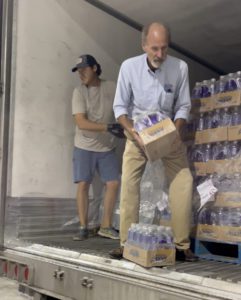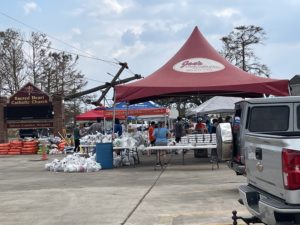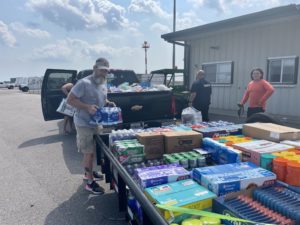Late on the evening of August 27, a tropical depression southwest of the Cayman Islands became Hurricane Ida. Twenty-four hours later, it was a Category 1 hurricane. By August 29, Ida had picked up steam over the warm waters in the Gulf of Mexico and became a Category 3. As Ida neared landfall at Port Fourchon on the Louisiana coast, it reached peak intensity, with 1-minute sustained winds of 150 mph. Ida caused extreme damage in Louisiana, with storm surge and rain causing widespread flooding and water damage; winds caused extensive power outages throughout the southeastern U.S. Over five days, Ida caused catastrophic damage all the way up through New England.
Amie Leigh, director of public health initiatives for SEI, saw the destruction first-hand, deploying into south Louisiana in partnership with local organizations on the Gulf Coast to help with the initial response in the early aftermath of the event.
Initially, Amie was partnered with several organizations part of Voluntary Organizations Active in Disaster (VOAD) who were providing air support and supplies delivery out of Pensacola, Florida, with hundreds of volunteer pilots using their small private planes to support areas inaccessible by road. As many as 20 relief flights a day were operating at the height of the early response, full of supplies and relief workers. Goals for the early days were to establish places where people could access supplies and to reach people most in need of significant support. Amie’s role included setting up forward operations for multiple organizations and identifying local organizations to partner with who could provide ongoing support for their communities.
“In disasters there are always flurries of organizations that come in to ‘save the day’,” says Amie. “Although they are very much needed and valued, they are temporary, on the ground for perhaps a week or a month. Disasters start local and end local, so an optimal early response includes finding the local organizations that are already there and who will be there for the months and years that follow, supporting them to be strong when they are feeling the weakest, knowing the pressure on them will be immense. In Ida’s case, that included Bless Your Heart, a nonprofit in LaRose, Louisiana, and Sacred Heart Catholic Church in Cut Off, Louisiana. During times like these, community resources often need a little bit of ‘stealth’ mental health from others, not official therapy sessions but specific techniques for grounding, stabilizing, and providing encouragement as these organizations begin to feel the burden of being responsible for their community.”
Most relief efforts were in Lafourche Parish and Terrebonne Parish, serving towns that were intensely impacted and full of social vulnerabilities, such as Golden Meadow, Cut Off, and LaRose. The consortium of responders included Aerobridge, Krewe De Andres Du Pez (a Mardi Gras crew from Pensacola), Crossroads Alliance Ministries, a supply delivery organization, Capacity Path Relief, and World Compassion Network.
“To be most effective in a disaster, collaboration is critical,” says Amie. “Together, these groups unloaded semi-trucks of supplies, packed planes, and helped get volunteers signed up on the days when the resources would be distributed. They flew in hot meals prepared by church groups and even fresh donuts from Krispy Kreme! We also were invited to engage with the Houma Nation headquarters—there are 17,000+ tribal members south of New Orleans—to be a direct supply resource to that community. We saw areas down the bayou where it appeared 80% to 90% of the homes are completely totaled, and distraught families with no electricity or fuel and no idea how to begin repair. It is profoundly heart-wrenching.”
In the first few days, volunteers spent 16 to 18 hours a day setting up operations and coordinating with emergency management professionals such as parish presidents, the port authority, and local law enforcement. The volunteer pilots dropped in supplies from Texas and Florida. As supplies on the ground were adequate for the immediate need, distribution sites were set up for longer-term “survival supplies;” water was distributed by driving through the communities. “In some areas, water was expected to be out for weeks,” says Amie.
At the points of distribution, Amie shared with families the resource of Crisiscleanup.org, to bring a sense of support and hope. Crisiscleanup.org provides a hotline survivors can call to get volunteers to help them with roof tarping, tree removal, or “mucking and gutting” their houses—a situation when the roof is gone or significantly damaged and the walls or flooring need to be taken up before mold grows, which adds to unhealthy and unsanitary conditions.
In LaRose, Amie met the district attorney and the on-staff therapist, both of whom are committed to the mental wellness of their community. Together, they provided on-the-spot mental health stabilization resources at the supply distribution pod and have continued in collaborative conversations with Americares, a global medical VOAD, to explore setting up mobile mental wellness clinics, a possible opportunity for SEPs in the future.
“Each new disaster or crisis—whether it’s a wildfire, a hurricane, or a flood—leaves people with questions about what can be done to relieve distress,” says Amie. “Our SE community is no different—we know many of you are inspired to keep exploring your own capability to serve at times like this. In her book A Paradise Made in Hell: The Extraordinary Communities that Arise in Disaster, author Rebecca Solnit describes the hidden nodes of helpers who experience strength, resilience, capacity, or connections they never imagined possible. We invite you to connect with us as we examine how to develop volunteer response teams using SE—and become part of those hidden nodes of helpers.”
SEI is developing a new program for SE-informed crisis intervention, called Crisis Stabilization and Safety (CSS), that we are test-piloting around the country in the next few months. We will be looking to the SE community to identify potential facilitators and people who would like to be trained in the short program, or to work with us in response efforts. If you would like to be added to a roster of people interested in deploying to volunteer in a disaster, please email us at publichealth@traumahealing.org with your interest and background and “disaster relief” in the subject line. We have the names of all who provided us their names after the start of COVID and will add more to it as this program and these efforts grow. As we have updates about CSS, we will keep you posted on that as well. Come to the conference to hear all about the CSS program at a live session on Friday, October 22, at 3:15pm.
Other Ways to Help
If you’re interested in long-term help for victims of Hurricane Ida, consider connecting with the following groups in south Louisiana:
Team Rubicon www.Teamrubiconusa.org
All Hands and Hearts Smart Response https://www.allhandsandhearts.org/
Operation Blessing www.ob.org
Helping Hands www.justserve.org/mormonhelpinghands



